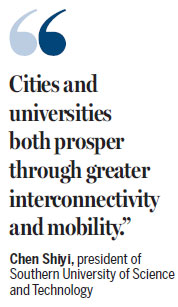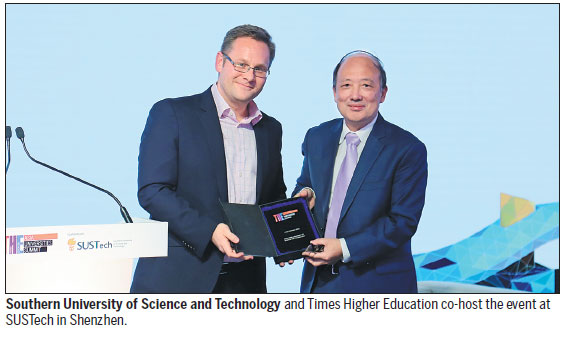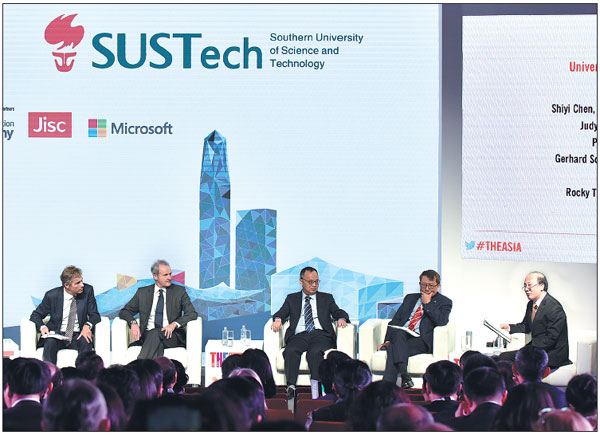Summit centers on university cooperation with urban growth
SUSTech, Times Higher Education co-host influential education gathering, Chen Hong reports.
Research universities are playing a more important role in sharpening cities' competitiveness and serving their industrial development, leading educators agreed in a summit in Shenzhen.
"Cities and universities both prosper through greater interconnectivity and mobility," said Chen Shiyi, president of Southern University of Science and Technology, also known as SUSTech.
He was speaking at the opening of the Times Higher Education Asia Universities Summit 2018 on Tuesday.
The summit, which among other things announced the results of the Times Higher Education Asia University Rankings 2018, ran from Feb 5-7 in Shenzhen.
"Collaboratively, they construct the trajectory of a learning society and knowledge economy, and tackle the challenges faced by the world," Chen said.

Some 400 participants from 29 countries and regions attended the summit to discuss, debate and discover how Asian research universities are transforming the future, including 25 renowned university presidents from China and abroad delivering speeches. They convened to seek solutions for building regional alliances, working with local businesses and facilitating entrepreneurship.
The summit was hosted by SUSTech and Times Higher Education or THE - the pre-eminent London-based magazine, formerly known as The Times Higher Education Supplement, that covers news and issues related to higher education.
THE provides one of the world's most influential and respected university rankings.
The summit's guiding theme was "connecting cities, changing the world: research universities building Asia".
University of South Florida President Judy Genshaft said the event was a landmark, as it was the first time that it took place in a Chinese mainland city. "It's very important for universities to work together to make life better for people all around the world, as well as for us, and to provide a better-educated workforce for companies and industry," she said.
Shenzhen, the southern Chinese host city of the summit, is a "big and terrific city with a lot of industries", Genshaft noted.
"They look to the universities for knowledge, for solutions, for a workforce and for new discoveries," she said.
Serving the city
University campuses can be experimental and transformational places that address major issues facing local governments, with the application of new technologies, according to some of the speakers.
President of Nanyang Technological University in Singapore, Subra Suresh, said the latest technologies - including artificial intelligence, data analysis and sensors - have been used on its campuses for improving the city-state's efficiency and environment.
He said many of his university's campuses have adopted new materials in their buildings and new energy-saving measures for the exploration of the properties of green buildings.
As a result, the campuses have been turned "smart" to help Singapore get "smarter", he added.
University of Macao Rector Song Yonghua said the university was collaborating with the government in smart energy, smart transportation and smart tourism.
The Macao Special Administrative Region government is also seeking solutions from the university to diversify its commercial base - which currently relies heavily on entertainment, gaming and gambling - according to Song, a world-renowned scholar in electrical engineering who assumed the office of rector in early January.
Chinese University of Hong Kong President Rocky S. Tuan said universities in big cities should provide a timely response to the needs of local residents.
"Government and universities should work together to address the fundamental problems of the city, such as the aging problem," Tuan said.
They can also work together on the "smart society", including smart mobility, smart environment, smart economy and smart buildings, low-carbon transportation, climate change, medical services and innovation, he said.
The government must have farsighted policies on educational development, while universities should develop their own workforce, rather than depend on recruiting professionals from other regions, and nurture their own culture, he noted.
Government support
Wang Weizhong, Party chief of Shenzhen, said the technology-driven city has always given priority to developing education and an excellent workforce.
"We have brought in a great number of educators, famous professors and academic leaders with international experience over the years, who contributed to building top-ranking universities and disciplines for the city," Wang said.
Shenzhen generated 2.24 trillion yuan ($357.5 billion) in GDP last year, ranking it third biggest among Chinese mainland cities, of which 4.13 percent went into research and development, according to official figures.
"We will develop more positive, more open and more efficient recruitment policies to attract talent around the world," Wang said. "We also invite famous universities across the globe to set up a presence in Shenzhen."
Wang praised the progress made by SUSTech, an experimental university launched in 2010. "From its establishment, it aimed to be a world top-ranking research university. It has provided a successful model for fast growth for local universities."
SUSTech President Chen said the resources provided by the city fed the engine that in turn propelled the growth of the university.
"The relationship between higher education and the city's development is a critical issue, especially at a time when China has demonstrated strong economic performance," Chen said.
"I firmly believe that economic development can better support educational development, while advances in higher education can serve as the engine to drive the local economy."
Contact the writer at chenhong@chinadaily.com.cn

|
Chen Shiyi (far right), president of Southern University of Science and Technology, also known as SUSTech, hosts a discussion session at the Times Higher Education Asia Universities Summit 2018 held in Shenzhen, Guangdong province from Monday to Wednesday. Photos provided to China Daily |
(China Daily 02/09/2018 page12)















